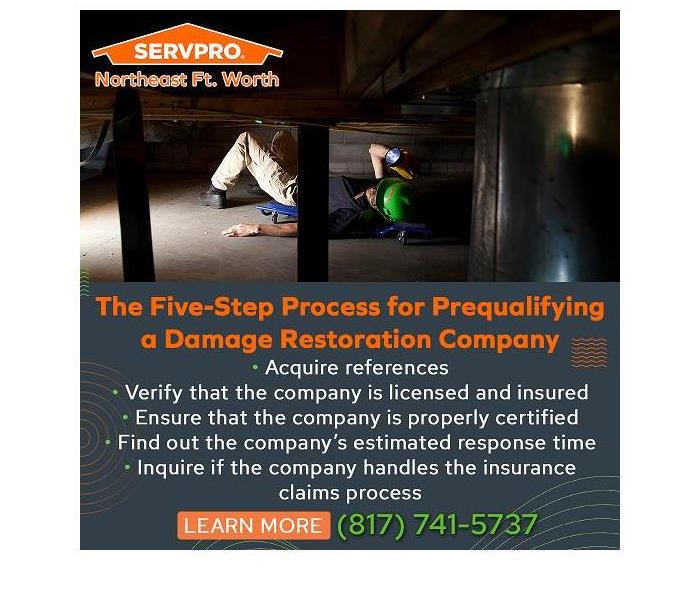Five Factors to Consider When Prequalifying a Watauga, TX, Damage Restoration Company
4/13/2022 (Permalink)
Blog Summary: Prequalifying a damage restoration company before disaster strikes is an effective strategy to expedite the start of the damage restoration process. SERVPRO of Northeast Fort Worth outlines a five-step process for selecting a service provider.
Prequalifying a restoration company can be one of the most powerful strategies for receiving rapid water damage restoration, fire damage restoration, or storm damage restoration services. Prequalification eliminates the scramble to locate and select a service provider in the immediate aftermath of a property damage disaster. When the homeowner has already chosen a dedicated damage restoration company, he or she can immediately place a call for emergency restoration services.
The Five-Step Process for Prequalifying a Damage Restoration Company
Step 1: Acquire references.
The homeowner’s insurance company may be able to recommend a cleanup and restoration service provider that it has worked with in the past. Also, family members, friends, and neighbors are valuable sources of information about local companies. Both positive and negative experiences can be helpful in narrowing down the selection list. Online review sites are another asset to the homeowner; however, it can sometimes be difficult to determine if an online review is legitimate. For this reason, trusted friends and family members who live in the community will likely provide the best references.
Step 2: Verify that the company is licensed and insured.
Hiring an uninsured and unlicensed company could be disastrous for the homeowner. If an uninsured company is contracted for restoration services and a technician is injured on the homeowner’s property, the homeowner could be sued for compensation. Choosing an insured company is especially important when restoration and cleanup services are needed since technicians may be working in an environment where the building is not completely structurally sound and where potentially hazardous substances are present.
A contractor’s license is one of the most fundamental requirements for a restoration company. An unlicensed company poses a great liability to homeowners, who could find themselves responsible for faulty and substandard work, as well as any additional property damage caused by the unlicensed contractor. Licensing provides legal protection for both the homeowner and the damage restoration company, so make sure that all companies on the shortlist are licensed and insured.
Step 3: Ensure that the company is properly certified.
In the restoration, cleaning, and inspection industries, an international organization called the Institute of Inspection, Cleaning, and Restoration Certification (IICRC) sets the standards for industry certification. The IICRC certifies both firms and individual technicians. 26 technician education certifications are offered, including:
- Applied Microbial Remediation Technician (AMRT)
- Applied Structural Drying Technician (ASD)
- Carpet Cleaning Technician (CCT)
- Commercial Carpet Maintenance Technician (CCMT)
- Fire and Smoke Damage Restoration Technician (FSRT)
- Odor Control Technician (OCT)
- Trauma and Crime Scene Technician (TCST)
- Upholstery and Fabric Cleaning Technician (UFT)
- Water Damage Restoration Technician (WRT)
Completion of IICRC certification testifies to a technician’s expertise and skill in his or her field of specialty. When selecting a damage restoration and cleanup company, look for an IICRC certified firm whose technicians have a broad array of certifications.
Another relevant certification is the Environmental Protection Agency’s certification for Lead Renovation, Repair and Painting (RRP). According to the EPA, “EPA’s Lead Renovation, Repair and Painting Rule (RRP) Rule requires that firms performing renovation, repair and painting projects that disturb lead-based paint in homes, child care facilities and pre-schools built before 1978 be certified by EPA (or an EPA-authorized state), use certified renovators who are trained by EPA-approved training providers and follow lead-safe work practices.” If homeowners suspect that their home contains lead-based paint, they should be vigilant to make sure that any restoration company they are considering hiring is certified and equipped to safely operate in an environment where lead is present.
Step 4: Find out the company’s estimated response time.
The ability to rapidly respond to property damage emergencies is an important qualification for a restoration company. In situations such as water damage, fire damage, and storm damage, delay in addressing the initial issue can lead to advanced secondary damage.
An ideal response time would be 24 hours a day, 7 days a week, 365 days a year, including holiday availability. In addition, some companies offer further assurance of a rapid response. For instance, SERVPRO of Northeast Fort Worth is committed to having its team of technicians arrive on the scene of a property damage emergency within four hours or less.
Step 5: Inquire if the company handles the insurance claims process.
Navigating the insurance claims process can be difficult and stressful for a homeowner experiencing a property damage disaster. For this reason, homeowners want to identify a water damage restoration company that will work with clients and their insurance providers to manage the claims process and the accompanying paperwork.
To learn more about SERVPRO of Northeast Fort Worth’s water damage, fire damage, and storm damage restoration services in Watuaga, TX, Keller, TX, and surrounding areas, contact the office by phone at (817) 741-5737 or by email at office@SERVPROnortheastftworth.com





 24/7 Emergency Service
24/7 Emergency Service
